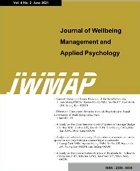 E-ISSN : 2586-6036
E-ISSN : 2586-6036
Vol.4 No.1
Abstract
Purpose: The study sought to uncover the effect of emotional labour strategies (surface acting and deep acting) on job satisfaction and emotional exhaustion. The study also purposed to analyse the moderating effect of organisational support (supervisory support and co-worker support) and the role of gender on emotional labour connotations. Research design, data and methodology: A conceptual framework was developed using extant literature which led to the examination of deep acting and surface acting, which are the two main strategies of emotional labour. The outcome variables were emotional exhaustion and job satisfaction. Data was collected from front line employees of banks and was analysed using SEM-AMOS version 21. Results: It was revealed, in this study, that surface acting is inversely related to job satisfaction and positively related to emotional exhaustion, whereas deep acting was positively related to job satisfaction and inversely related to emotional exhaustion. The roles of gender and organisational support were also confirmed. Conclusions: The study therefore concluded that deep acting is the most ideal strategy of emotional labour as it leads to job satisfaction and reduced emotional exhaustion. Surface acting is a harmful emotional labour strategy.
Abstract
Purpose: This study aims to explore the correlation between job and hypertension. Hypertension is a major risk factor such as stroke, myocardial infarction, heart failure, and vascular aneurysms. Research design, data and methodology: The data from this study are the 2017 National Health and Nutrition Examination Survey classified into office workers and non-office workers. Frequency analysis was used for general characteristics analysis, and ANOVA test analysis was used for correlation between subjects' basic variables and blood pressure. The post analysis as turey was used to verify the validity of the statistical results. All statistical analyzes were performed using the IBM SPSS 24.0 program. Results: There was a difference in the prevalence of hypertension among office workers and non-office workers.
Abstract
Purpose: This study seeks to develop behavior-induced automatic separation X-Bin for disposable cup speculators. Some students throw away the contents. Research design, data and methodology: Therefore, environmental beautification workers spend a lot of time sorting disposable cups at school garbage collection sites. Disposable cups that have been thrown away like this are bad in terms of appearance and smell. In addition, cleaning inside garbage affects recycling rates and is closely related to environmental problems. Results: Clean cleaning reduces the amount of garbage incinerated without being recycled and reduces the cost of recycling. According to Korean Social Trends 2020, COVID-19 began to spread, and recycling of disposable items such as disposable cups increased by about 15 percent from the same period last year. Conclusions: These are classified for recycling, and the amount of garbage thrown on the streets is estimated to be larger. In order to prevent COVID-19s, the use of disposable goods is inevitable, but facilities are needed to dispose of them properly.
Abstract
Purpose: The number of people with disabilities and the elderly over 65 years of age is gradually increasing due to physical disabilities and social aging. Their typical physical disorders or chronic diseases include low back pain, sciatic pain, arthritis, and musculoskeletal systems such as discs. The average prevalence of disease is 78%. These are various physical obstacles and hindrances in daily life. Research design, data and methodology: From August 6, 2019 to September 24, 2019, the Senior Welfare Center in Gyeyang-gu, Incheon, operated a healthy body exercise and health education program for living health management. Results: The vascular health index using U-Bio pulse wave was relatively good at the first average of +7.4, but the second average of -6.3. This can be seen as a result of the combination of diet and lifestyle education along with the effect of corrective exercise. As a result of body shape measurement analysis, the number of persons requiring management with 3 or more body imbalances was found to be from 75% before to 62.5% afterwards. Conclusions: Exercise effect appears when exercise lasts for at least 10 weeks. Some performances were good, but there were limitations due to the operation of a short training period.













